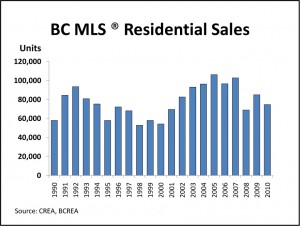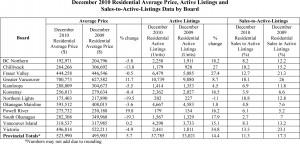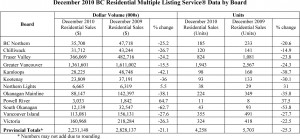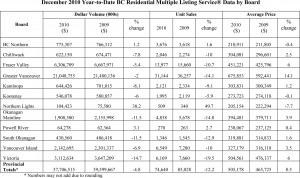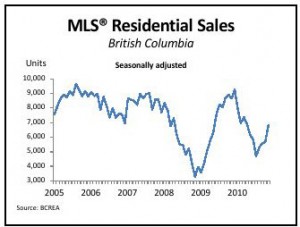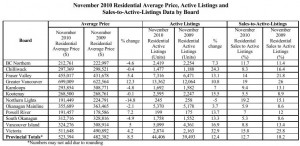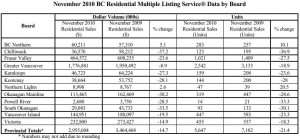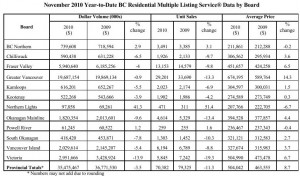The B.C. Real Estate Association published their mortgage rate outlook in December 2010 looking forward into 2011. I have included the full PDF link at the bottom of this article. The full PDF includes charts and graphics that are not included in this post.
Following a period of relative calm, global financial markets have again been unsettled by fiscal instability in Europe and uncertainty regarding the Federal Reserves’ ability to spur the US economy out of its current doldrums. Amidst this economic backdrop, key government bond yields have reversed their downward trend, moving sharply higher. In our final mortgage rate forecast of 2010, we discuss what these trends mean for mortgage rates over the coming year.
Growth and Inflation Outlook
The Canadian economy has slowed sharply following a blistering start to the year. Real GDP growth was just 1% in the third quarter, down from the 2% growth posted in the second quarter. Much of the drag in Canadian economic activity is due to continued weakness in the United States and other export markets, though domestic demand has also begun to soften. We expect these trends to hamper growth for the remainder of 2010 and into 2011. A sharper than expected slowing of the economy has prompted us to trim our forecast of real GDP growth to 2.9% this year and 2.1% in 2011.
Moderate economic growth in 2011 will translate to continued slack in Canadian product and labour markets. This slack, along with a strong loonie, will provide a bulwark against inflation and therefore a continuation of accommodative monetary policy by the Bank of Canada.
Interest Rate Outlook
In the face of slowing growth, muted inflation and lingering global financial instability, the Bank of Canada has held its overnight rate at 1.00% since September. Although the Bank’s medium-term objective of returning rates to normal long-run levels is still intact, the Bank will take a very cautious approach to tightening monetary policy over the next 6 to 12 months. Given that inflation is projected to remain subdued and growth is expected to slow, we do not expect any action from the Bank of Canada until the second quarter of 2011, if not later.
Our current forecast is for the Bank of Canada’s target overnight rate to rise from its current level of 1.00% to between 1.75% – 2.00% by the end of 2011. Moving down the yield curve there are a number of factors muddying the outlook for interest rates important to mortgage pricing.
First and foremost is the impact of the US Federal Reserve’s implementation of further quantitative easing, or so called “QE2”. In early November the Federal Reserve announced that its new quantitative easing program would expend up to $600 billion by the end of June 2011 in order to help spur the flagging US economy. Federal Reserve Chairman Ben Bernanke outlined three explicit goals of this policy:
• Lower mortgage rates for US homebuyers to increase affordability and promote refinancing
• Lower corporate bond rates to encourage private investment and boost economic growth
• Increase asset prices to boost consumer wealth and increase confidence.
To that list, we would add two further unstated, but not unwelcome, goals. The first being the engineering of a lower US dollar to spur American exports, and the second, a much needed change in the path of inflation from its current and potentially devastating “Japan-like” disinflationary trend. However, a curious thing has happened since the official announcement of QE2, the yield on 5-year US Government Bonds – along with its Canadian counterpart – has risen substantially. This reversal in yields has erased a large portion of the beneficial fall in rates since QE2 was first hinted at in August. It isn’t immediately clear what is driving the sudden change in the direction of interest rates.
Analysts have pointed to culprits ranging from a foreign backlash against QE2 to a welcome increase in future inflation expectations. Given that QE2 is only in its beginning stages, it is likely too early to say with any certainty how rates will evolve in coming months. What is certain is that volatility in bond markets is likely to be around a while longer.
Mortgage Rate Forecast
The unexpected rise in yields prompted a fairly dramatic repricing of mortgages in November. After falling to an all-time low of 5.19%, the 5-year mortgage rate has leapt 25bps to 5.44% while the 1-year rate increased from 3.20% to 3.35%. Heightened volatility in bond markets could mean a re-testing of mortgage rates lows, particularly if a deepening Euro-crisis prompts a flight to safety in US and Canadian treasuries. A more likely outcome is that mortgage rates will stay flat for the next quarter as investors re-evaluate growth and inflation expectations in the context of a QE2 world.
Our expectation for 2011 is that rates will begin a slow march upwards, hovering slightly higher than current levels for the first half of 2011. Rates will then be prompted higher by expectations of renewed, but cautious, rate tightening by the Bank of Canada in the second half of next year. The BCREA forecast for the 1-year mortgage rate to average 3.3% in 4th quarter of 2010 and to reach 4.4% by the end of 2011. The 5-year fixed mortgage rate will average 5.30% for the 4th quarter of 2010 before increasing to 5.90% in 2011.

